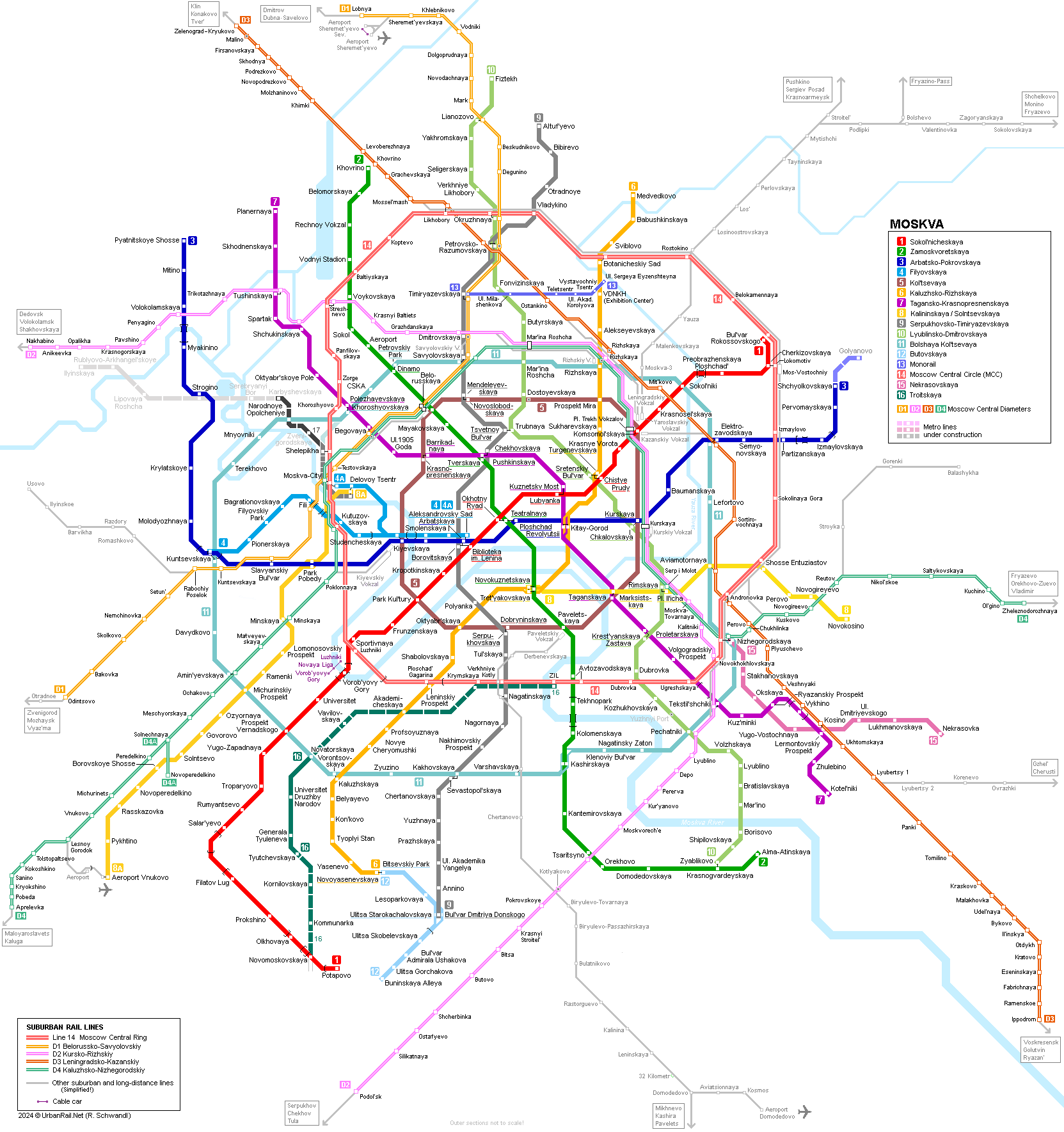|
[ UrbanRail.Net ] [ Europe ] [ Americas ] [ Asia ] [ Africa ] [ Oceania ] [ News ] [ Books ] [ Links ] |
|
MOCKBA . MOSKVA
|
| Russia |

|
[ UrbanRail.Net ] [ Europe ] [ Americas ] [ Asia ] [ Africa ] [ Oceania ] [ News ] [ Books ] [ Links ] |
|
MOCKBA . MOSKVA
|
| Russia |

| METRO | |||||||||||||||||||||||||||||||||||||||||||||||||||||||||||||||||||||||||||||||||||||||||||||||||||||||||||||||||||||||||||||||
|
Moscow became the capital of Russia and the Soviet Union after the revolution of 1917. Then it had 1.7 million inhabitants. In 2010 the city has 11.5 million inhabitants on an area of 1081 km2 (40 km from one side to the other). In 1932 construction of Moscow's metro began as a piece of art with elegant and huge stations. Today the Moscow metro seems to be the busiest in the world, carrying an average of 8-9 million passengers on a normal weekday, i.e. some 3,000,000,000 (!) a year.
The first line opened on 15 May 1935 between Sokol'niki and Park Kul'tury with a branch to Smolenskaya which reached Kievskaya in April 1937 (crossing Moskva river on a bridge). Two more lines were opened before World War II. In March 1938 the Arbatskaya line was extended to Kurskaya station (now Arbatsko-Pokrovskaya - dark blue line). In Sept. 1938 the Gorkovsko-Zamoskvoretskaya line opened between Sokol and Teatral'naya (without Tverskaya station which was added in 1979). The projects of the third stage of the Moscow metro were delayed during the War. Two metro sections were put into service: Teatralnaya - Avtozavodskaya (3 stations, crossing the Moskva river in a deep tunnel) and Kurskaya - Partizanskaya (ex Izmaylovskiy Park - 4 stations). After the War construction started on the fourth stage of the metro, which included the Kol'tsevaya line and a deep part of the Arbatsko-Pokrovskaya line from Pl. Revolyutsii to Kievskaya. The Kol'tsevaya line was planned first as a line running under the Sadovoye Koltso (Garden Ring), a boulevard ring running along the limits of 16th century Moscow. The first part of the line - from Park Kul'tury to Kurskaya (1950) is indeed situated under this boulevard. But later plans were changed and the northern part of the ring line runs 1-1.5 km outside the Sadovoye Koltso, thus providing service for 7 (out of 9) railway stations. The next part of the Kol'tsevaya line opened in 1952 (Kurskaya - Belorusskaya) and in 1954 the ring line was completed. |
|||||||||||||||||||||||||||||||||||||||||||||||||||||||||||||||||||||||||||||||||||||||||||||||||||||||||||||||||||||||||||||||
|
The reason for the construction of a deep part of the Arbatskaya was the beginning of the Cold War. Stations are very deep and were planned to serve for hiding people even in the case of nuclear war. After finishing the line in 1953, the upper tracks between Pl.Revolyutsii and Kievskaya were closed. In fact they were reopened in 1958 as a part of the Filyovskaya. In the further development of the metro, the term stages was not used anymore, although sometimes the stations opened in 1957-1958 are referred to as the fifth stage. [View a station by station depth map created by Alexey Goncharov] The Moscow Metro has standard Russian gauge, 1520 mm, and third rail supply. The average distance between stations is 1790 m (!), the shortest with 500 m is between Vystavochnaya and Mezhdunarodnaya (Line 4), and the longest with 6.6 km between Krylatskoye and Strogino (Line 3). At 73 m below the surface, Park Pobedy is among the deepest stations in the world. With the exception of lines 4 and 12, all station platforms have been consistently built 162 m long. Whereas most transfer stations have two separate stations carrying two different names and connected by foot tunnels, six offer convenient cross-platform transfer: between lines 6 and 7 at Kitay-Gorod, between lines 2 and 11 at Kashirskaya, between lines 6 and 8 at Tret'yakovskaya, between lines 3 and 4 at Kuntsevskaya, between lines 3 and 8A at Park Pobedy and between lines 9 and 10 at Petrovsko-Razumovskaya. The metro network is complemented by an expanding S-Bahn-style rail network which comprises a circular line (MCC, line 14, metro-style frequency) and two cross-city lines (MCD). |
|||||||||||||||||||||||||||||||||||||||||||||||||||||||||||||||||||||||||||||||||||||||||||||||||||||||||||||||||||||||||||||||
| Lines | |||||||||||||||||||||||||||||||||||||||||||||||||||||||||||||||||||||||||||||||||||||||||||||||||||||||||||||||||||||||||||||||
|
|||||||||||||||||||||||||||||||||||||||||||||||||||||||||||||||||||||||||||||||||||||||||||||||||||||||||||||||||||||||||||||||
| History | |||||||||||||||||||||||||||||||||||||||||||||||||||||||||||||||||||||||||||||||||||||||||||||||||||||||||||||||||||||||||||||||
|
View a chronological map created by Alexey Goncharov |
|||||||||||||||||||||||||||||||||||||||||||||||||||||||||||||||||||||||||||||||||||||||||||||||||||||||||||||||||||||||||||||||
|
The following sections are currently under construction: More details about Moscow Metro projects (by Yuri Popov)
|
|||||||||||||||||||||||||||||||||||||||||||||||||||||||||||||||||||||||||||||||||||||||||||||||||||||||||||||||||||||||||||||||
| Links | |||||||||||||||||||||||||||||||||||||||||||||||||||||||||||||||||||||||||||||||||||||||||||||||||||||||||||||||||||||||||||||||
|
Moscow Metro - Official Site Moskovskiy Transport - Official Site MosMetrostroy - Metro Construction Site Moscow Urban Development Office > Metro Moscow Metro at Wikipedia Metrowalks.ru - The Ultimate Photo Gallery including all Moscow metro stations by Igor Vanin Artemiy Lebedev's extensive metro.ru site (in Russian only) incl. lots of maps (new 2003 official map) Yuri Gridchin's Metropoliten site includes an animated history map Mockobckoe Metpo - Moscow Metro Paleometro by Alexandr Mironenko
|
METROCARS - Anything about Metro Trains in the ex-USSR Voices in the Underground by Artemiy Y. Lomov Mir Metro - Metroworld by Dmitry Aksenov, Di. Vendox and Andrey Surikov METRO - not at first sight by Artemiy Y. Lomov Metrostroy (Metro construction) by Andrey Surikov Peter Donn's Underground Stations includes excellent pictures of some stations Various Moscow Metro Maps (by depth, chronological, etc.) by Alexey Goncharov |
||||||||||||||||||||||||||||||||||||||||||||||||||||||||||||||||||||||||||||||||||||||||||||||||||||||||||||||||||||||||||||||
|
|
|||||||||||||||||||||||||||||||||||||||||||||||||||||||||||||||||||||||||||||||||||||||||||||||||||||||||||||||||||||||||||||||
2004 © UrbanRail.Net by Robert Schwandl.